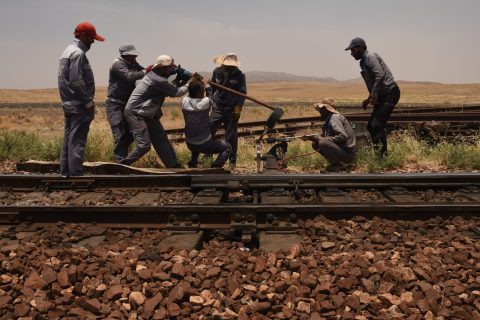Fesco’s chairman in China: these are the visit’s outcomes

Andrey Severilov, the Chairman of the Board of Directors of FESCO, had a busy business agenda in China in April. Transiting between Beijing, Shandong and Shanghai, he discussed cooperation in the rail and intermodal industries with stakeholders ranging from Sinotrans and national chemical giants to ambassadors. What developments can this trip bring for the rail world?
China number-one partner
On 24, Fesco announced that Severilov had met with Russian Ambassador Igor Morgulov in Beijing to discuss cargo volume development and prospects between China and Russia.
“China’s share in foreign trade container turnover with Russia is currently at its peak, at around 70 per cent,” said Severilov. “China is undoubtedly our number one strategic partner.”
Intermodal chemical transportation
On April 20th, again in Beijing, Fesco signed a quadripartite agreement with China National Chemical Engineering Company (CNCEC), Heilongjiang Transportation Investment Group, and Xinjiang Energy Group to promote cross-border intermodal transportation.
Heilongjiang is a province in northeastern China sharing a border with Russia. China National Chemical Engineering Company (CNCEC), one of the biggest Chinese contractors in the chemical industry, is now a strategic partner of Fesco.
This partnership agreement signals cooperation in the fields of energy and chemicals between Russia and China. The intermodal landscape between Vladivostok, Heilongjiang, and Russia’s Far East provides a larger platform for Moscow to expand its presence in China.
Connecting Europe and Shandong
On 21 April in Jinan, the capital of Shandong province, Fesco announced that Severilov had signed a tripartite cooperation agreement with Margin Group International Logistics and Shandong Hi-Speed Qilu Eurasia Railway Logistics Company, the leading logistics operator in the province.
The agreement aims to establish a service connection between Shandong and Europe via Russia, which will involve border crossings not only by rail but also by sea through the far east port of Vladivostok, which is under Fesco’s management.
Increase Tongjiang bridge capacity
At the same meeting, the tripartite agreement also covered the development of terminal capacities, specifically on the Russian side. Fesco emphasised that the development would focus on the capacity of the Nizhneleninskoye-Tongjiang checkpoint.
The Tongjiang Bridge is the first railway bridge between China-Russia. However, in a recent interview with Chinese forwarders, none confirmed using the bridge in their network. According to Linlin Zhu, founder of LLC Translogistics, the bridge may be more suitable for bulk commodities like grain and coal rather than block trains.
Shanghai to Moscow route
On 24 April, Fesco announced that it would collaborate with Shantex Group International Logistics to develop transportation services.
The two parties signed a memorandum of understanding. They announced that they will provide regular train services between Shanghai and Moscow for the transportation of various goods, including design and chemical (including dangerous) goods, fertilisers, and transportation in tank containers and refrigerated containers.
Reaching South East Asia
On 25 April, Fesco announced that it had discussions with Sinotrans regarding intermodal prospects. During the meeting, the two parties primarily focused on three business objectives: the route to Southeast Asia, Russian terminal capacities, and Africa and Turkey potentials.
Sinotrans has several port access points in Southeast Asia. Additionally, the newly developed China-Laos railway and western landbridge corridor connecting southwest cities like Chongqing with the port of Qinzhou will work together to facilitate the smooth cargo flow between Russia and Southeast Asia.
Also read:
-
What could Fesco’s partnership with a Chinese chemical giant entail?
-
Fesco bypasses Lithuania with St. Petersburg-Kaliningrad sea services
-
FESCO brings first batch of Chinese new energy vehicles to Moscow
You just read one of our premium articles free of charge
Want full access? Take advantage of our exclusive offer




